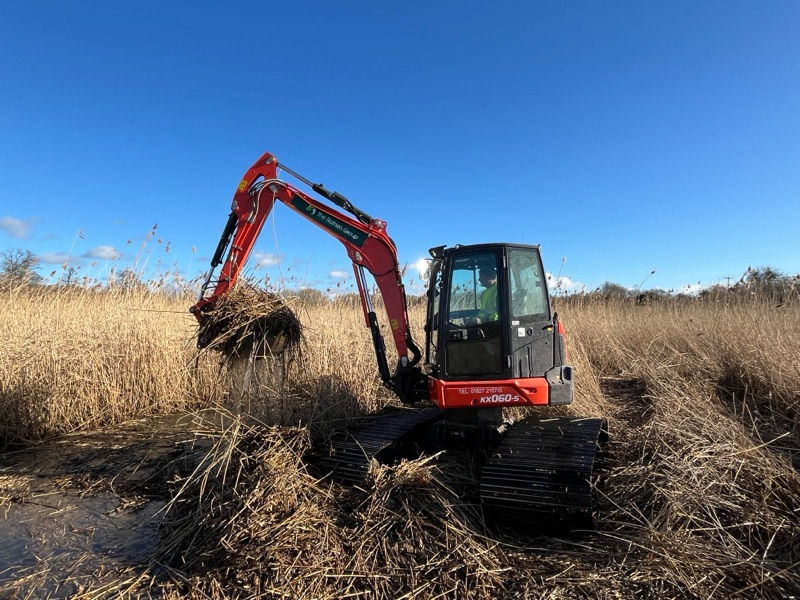
Reed & Weed
Reeds and weeds slow everything down. We remove excess aquatic vegetation without harming ecosystems, keeping canals and rivers navigable and flood-resilient.
Contract services
Our Specialist Aquatic Vegetation Management Services
Uncontrolled reed and weed growth doesn’t just look untidy – it can choke waterways, disrupt navigation, and increase flood risk. The Rothen Group targets problematic vegetation, removing it safely and carefully. This restores flows, improves access, and protects the long-term health of rivers, canals, lakes, and ponds.
From thick reed beds to invasive aquatic weeds, we’ve seen – and cleared – it all. We rely on a fleet of specially adapted weed-cutting and harvesting boats that can tackle floating, submerged, or blanket weeds. With numerous interchangeable cutting heads, rakes, baskets, and sidearms, we can reach awkward spots and remove vegetation from the canal or river – even in strong currents or restricted access sites.
There’s also the problem of offloading and disposal. We’ve got that covered too. Whether it’s into a hopper, onto the bank, or transported off-site for reuse as compost or topsoil, we manage the entire process, minimising damage to the local environment.
Got a problem with reeds and weeds? Contact The Rothen Group to find out how we can help manage your aquatic vegetation.

Dredging
View More

Lock
maintenance
View More

Lock
maintenance
View More

Dredging
View More

Dredging
View More

Lock
maintenance
View More

Lock
maintenance
View More

Dredging
View More

Gallery

FEATURED CASE STUDY
Habitat Creation Coney Meadows, Droitwich
Coney Meadows is part of a nationwide project to restore the UK’s wetlands. Since the 17th century, large areas of reedbeds have been stripped and converted into agricultural land, massively reducing the number of habitats available for wetland animals.

FEATURED CASE STUDY
Changing the Shape of the River Derwent, Derby
Following the storm seasons of 2023 & 2024, the EA set out to review its impact on the UK’s waterways. The River Derwent in Derby was flagged after a sonar scan of its navigation identified a scour hole – a direct result of heavy rainfall pushing sediment downstream.
Silt deposits often lead to excessive reed and weed growth. Alongside other aquatic vegetation, such as floating weeds and submerged weeds, these can block waterways, damage boats, and affect the flow of water.
Aquatic vegetation management is part of the routine maintenance of a waterway. If left uncontrolled, this plant matter can increase flooding risks, restrict boat movements (especially for narrow boats on canals), alter water flow, and disrupt habitats.
What is aquatic vegetation management?
Reeds and weeds might seem harmless – even picturesque. However, overgrowth can choke waterways, reduce depth, trap silt, and contribute to flow by obstructing it. It also poses a risk to boats and infrastructure.
The solution is routine reed and weed maintenance. For example, The Rothen Group works with the Canal & River Trust to manage a 20-mile-long section of water, dealing with floating weed, blanket weed, and marginal reeds. We remove around 6,600 m3 of weeds and 400 m3 of rubbish – a truly colossal amount.
This improves the health, usability, and long-term sustainability of our waterways.
Why does reed & weed maintenance matter?
We rely on a range of different specialised boats to remove and excavate weeds and reeds. Harvester boats, for instance, are specialised in dealing with floating weeds, e.g., duckweed, whereas long-reach excavators or crane boats can pull out deep-rooted reeds from even the hardest-to-reach locations.
Prior to each project, we perform a comprehensive assessment, determining the right machinery for the tasks. We’ll devise a complete plan, outlining the strategy and equipment needed for success.
How do you remove reeds and weeds?
From native plants to invasive species, the UK’s waterways host a wide range of aquatic vegetation, especially in slow-moving rivers and canals. Most people will recognise the plants as they walk along their local waterways. They include:
Floating Weeds. Floating pennywort, duckweed, lilies, blanket weed, and azolla
Marginal Rhizome. Common reed, bullrush, and bur-reed
Submerged Weed. Water weed and pond weed
What are the types of reeds and weeds?
That depends on the waterway. It’s not just about the visual presence of reeds or weeds but the overall purpose of the waterway. Generally, any form of aquatic vegetation is detrimental to the function of a canal; in contrast, reeds form a key natural ecosystem in some rivers.
So, what’s the surest sign removal is necessary? Thick vegetation, restricted flow, unpleasant odours, or stagnant patches are all red flags.
How do I know if my site needs reed or weed removal?
FAQ
Your questions answered
Our Accreditations
about us
A decade of
The Rothen Group
With decades of experience maintaining the UK’s inland waterways, The Rothen Group is a trusted name in aquatic vegetation management. From clearing invasive weeds to cutting back dense reed beds, we help keep canals, rivers, ponds and lakes flowing freely and looking their best.
Our skilled team includes engineers, plant operators and weed management specialists who care deeply about the health of our water systems. Using purpose-built machinery and environmentally sensitive methods, we deliver efficient, low-impact solutions that restore balance to even the most overgrown sites – safely, on time and with lasting results.























